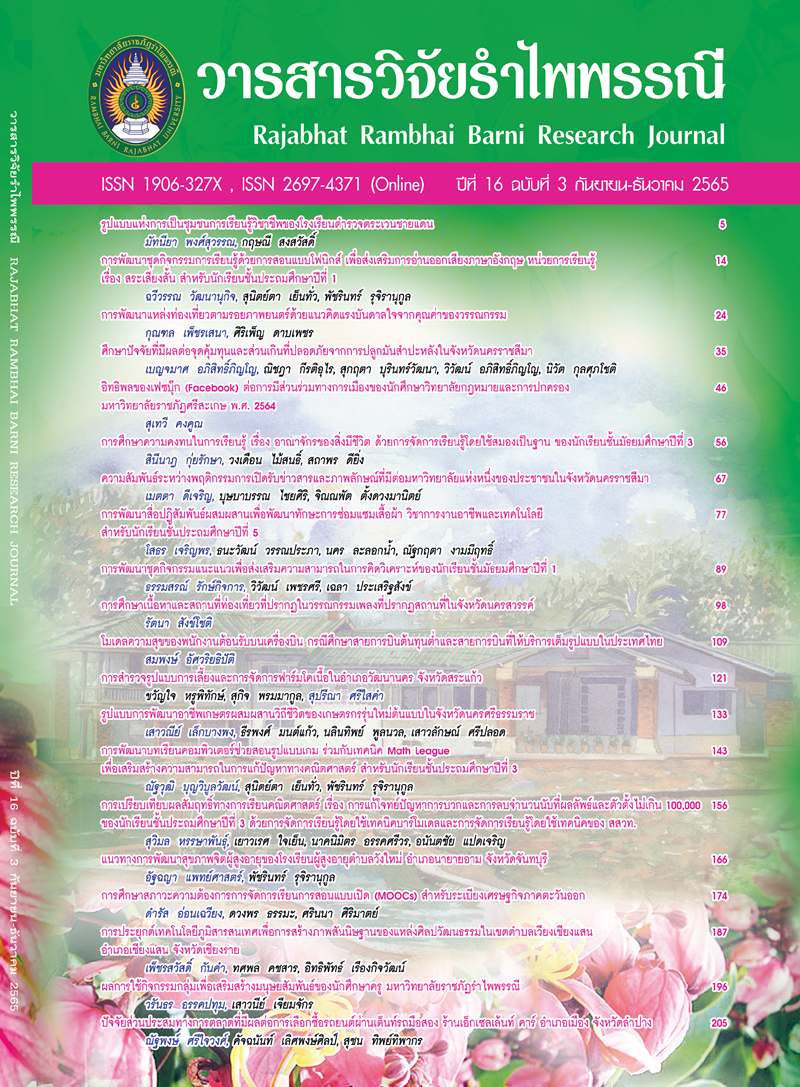การพัฒนาแหล่งท่องเที่ยวตามรอยภาพยนตร์ด้วยแนวคิดแรงบันดาลใจ จากคุณค่าของวรรณกรรม
Main Article Content
บทคัดย่อ
การศึกษาครั้งนี้มีวัตถุประสงค์เพื่อศึกษาแรงบันดาลใจจากคุณค่าของวรรณกรรมที่ส่งผลต่อการพัฒนาแหล่งท่องเที่ยวตามรอยภาพยนตร์ และเพื่อเสนอแนวทางการพัฒนาแหล่งท่องเที่ยวตามรอยภาพยนตร์ด้วยแรงบันดาลใจจากคุณค่าของวรรณกรรม เป็นการวิจัยเชิงคุณภาพโดยการสัมภาษณ์เชิงลึกผู้มีส่วนเกี่ยวข้องในแหล่งท่องเที่ยวตามรอยภาพยนตร์ ได้แก่ เจ้าหน้าที่หน่วยงานภาครัฐและประชาชนท้องถิ่น รวม 42 คน ในแหล่งท่องเที่ยวตามรอยภาพยนตร์ 3 ประเภท ได้แก่ แหล่งท่องเที่ยวตามรอยภาพยนตร์ซึ่งเป็นสถานที่จริง แหล่งท่องเที่ยวตามรอยภาพยนตร์ที่อยู่ในนวนิยาย และแหล่งท่องเที่ยวตามรอยภาพยนตร์ที่ถูกสร้างขึ้น และใช้การจำแนกชนิดข้อมูลและการวิเคราะห์เชิงเนื้อหาในการวิเคราะห์ข้อมูล
ผลการศึกษาพบว่าแรงบันดาลใจจากวรรณกรรมในการพัฒนาแหล่งท่องเที่ยวตามรอยภาพยนตร์ประกอบด้วย1) สร้างอัตลักษณ์ให้กับพื้นที่ 2) สร้างสภาพแวดล้อมการเรียนรู้ 3) สร้างสิ่งดึงดูด (ธีม) 4) สร้างแรงบันดาลใจ และ 5) นำเสนอประสบการณ์การท่องเที่ยวที่สอดคล้องกับจินตนาการ สำหรับแนวทางการพัฒนาแหล่งท่องเที่ยวตามรอยภาพยนตร์คือ 1) นำจุดเด่นของวรรณกรรมที่นำเสนอผ่านภาพยนตร์/ละครมาใช้ในการสร้างเอกลักษณ์ให้กับแหล่งท่องเที่ยว 2) พัฒนาแหล่งท่องเที่ยวให้สามารถตอบสนองกับจินตนาการของนักท่องเที่ยว และ 3) ความร่วมมือของทุกภาคส่วนที่เกี่ยวข้องกับแหล่งท่องเที่ยว
Article Details

อนุญาตภายใต้เงื่อนไข Creative Commons Attribution-NonCommercial-NoDerivatives 4.0 International License.
เอกสารอ้างอิง
วไลลักษณ์ น้อยพยัคฆ์ (2558). คุณค่าของประเทศไทยจากการรับรู้ของนักท่องเที่ยวสหราชอาณาจักร. จุลสารวิชาการการท่องเที่ยว. 1/2015. (มกราคม-มีนาคม), 12-19.
สุภัทรา บุญปัญญโรจน์ (2563). วรรณกรรมกับการท่องเที่ยว:เศรษฐกิจ (การท่องเที่ยว) สร้างสรรค์จากฐานรากวัฒนธรรม. วารสารมนุษยศาสตร์ ฉบับบัณฑิตศึกษา.9(1), 82-97.
อิราวดี ไตลังคะ (2543). ศาสตร์และศิลป์แห่งการเล่าเรื่อง. กรุงเทพมหานคร สำนักพิมพ์มหาวิทยาลัยเกษตรศาสตร์.
Agarwal, S., & Shaw, G. (2018). Heritage, screen and literary Tourism.Bristol: Channel View Publications.
Alonso, A. D., & Nyanjom, J. (2015). Local stakeholders, role and tourism development. Current Issues in Tourism. 20(5), 1-7.
Andrades, L., & Dimanche, F. (2017). Destination competitiveness and tourism development in Russia: Issues and challenges. Tourism Management. 62, 360-376.
Bass, B. M., & Avolio, B. J. (1994). Improving organizational effectiveness through transformational leadership. London: Sage Publications.
Beeton, S. (2016). Film-induced tourism. Bristol, Blue Ridge Summit: Channel View Publications.
Bidaki, A., & Hosseini, S.H. (2014). Literary tourism as a modern approach for development of tourism in Tajikistan. Journal of Tourism & Hospitality. 3(1), 1-4.
Connell, J. (2012). Film tourism–Evolution, progress and prospects. Tourism Management. 33(5), 1007-1029.
Driscoll, B. (2018). Local places and cultural distinction: The booktown model. European Journal of Cultural Studies. 21(4), 401-417.
Hede, A. M., & O’Mahony, G. B. (2004). The media and the development of the tourism industry during the 20th and 21st centuries: An analysis of four noteworthy cases. Paper presented at the ITAM Conference Proceedings, Tourism Research Unit, Monash University.
Herbert, D. (2001). Literary places, tourism and the heritage experience. Annals of tourism research. 28(2), 312-333.
Hoppen, A., Brown, L., & Fyall, A. (2014). Literary tourism: Opportunities and challenges for the marketing and branding of destinations? Journal of Destination Marketing and Management.3(1),37-47.
Hudson, S., Wang, Y., & Gil, S. M. (2011). The influence of a film on destination image and the desire to travel:A cross‐cultural comparison.International Journal of Tourism Research.13(2), 177-190
Jurowski, C., & Gursoy, D. (2004). Distance effects on residents' attitudes toward tourism.Annals of tourism research. 31(2), 296-312.
Juškelyte, D. (2016). Film induced tourism: destination image formation and development. Regional Formation and Development Studies. 19(2), 54-67.
Kim, S. (2012). Audience involvement and film tourism experiences: Emotional places, emotional experiences. Tourism Management. 33(2), 387-396.
Li, S., Tian, W., Lundberg, C., & Gkritzali, A. (2021). Two tales of one city: Fantasy proneness, authenticity, and loyalty of on-screen tourism destinations. Journal of Travel Research. 60(8), 1802-1820.
Liu, X., & Pratt, S. (2019). The downton abbey effect in flim-induced tourism: An empirical examination of tv drama-induced tourism motivation at heritage attractions Tourism Analysis. 24(4), 497-515.
Macionis, N. (2004). Understanding the film-induced tourist. Paper presented at the the International Tourism and Media Conference Proceedings, Melbourne: Monash University.
Macionis, N., & O’Connor, N. l. (2011). How can the film-induced tourism phenomenon be sustainably managed?-Conclusion. Worldwide Hospitality and Tourism Themes. 3(2), 87-90.
Mansfield, C. (2015). Researching literary tourism. Shadows Books & Media, Bideford.
Radomskaya, V. (2020). Popular Culture Tourism: trend or transition? In P. Pearce & A. n. Correia (Eds.), Tourism’s new markets: Drivers, details and directions. (pp. 141-153). Australia: Goodfellow Publishers.
Riley, R., Baker, D., & van Doren, C. S. (1998). Movie-induced tourism. Annals of Tourism Research 25(4), 919-935.
Robinson, M. & Andersen, H. C. (2004). Literature and Tourism: Essays in the reading and writing of tourism. Andover: Cengage Learning EMEA.
Roesch, S. (2009). The experiences of film location tourists. Toronto: Channel View Publications.
Scott, N., Baggio, R., & Cooper, C. (2008). Tourism destination networks and knowledge transfer Network Analysis and Tourism: From Theory to Practice. (pp. 40-57). Bristol, Blue Ridge Summit:: Channel View Publications.
Watson, N. J. (2006). The Literary Tourist. UK: Palgrave Macmillan.
Wang, Y., Li. Huang, J. Li, & Yang., Y. (2019). The Mechanism of Tourism Slogans on Travel Intention Based on Unique Selling Proposition (USP) Theory. Journal of Travel & Tourism Marketing. 36(4), 415-427.
Young, L. (2015). Literature, museums, and national identity; or, why are there so many writers' house museums in Britain?. Museum History Journal. 8(2), 229-246.


